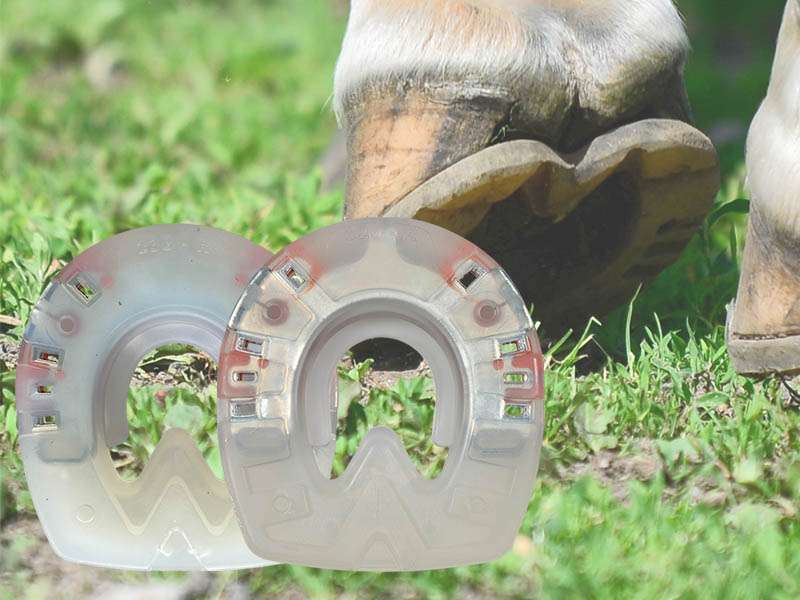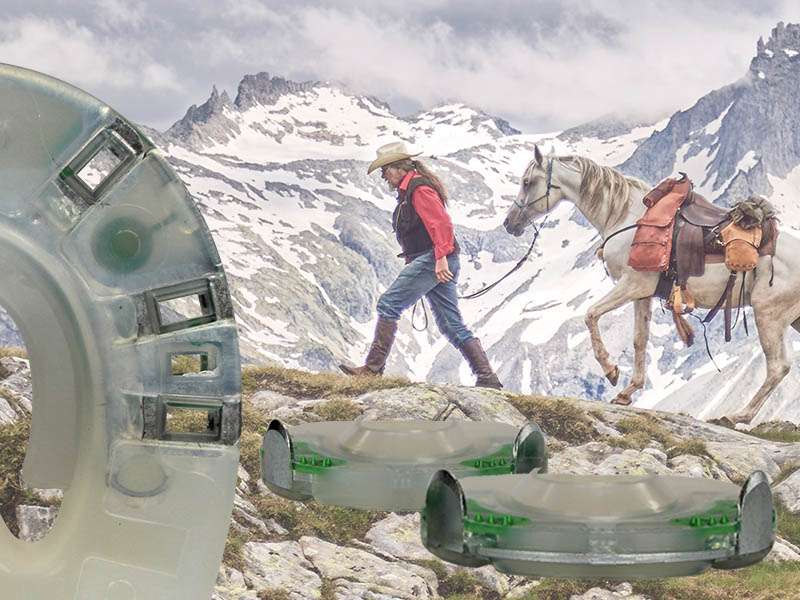Abrasion and Durability of Composite and Urethane Horseshoes
The overall abrasion resistance is associated with the ratio between the metal core and synthetic cover, as well as the hardness of the synthetic material used. However, the horseshoe alone does not determine individual durability. There are many factors involved, over which we have no control, such as the horse‘s boarding conditions, gaits, and overall behavior, the riding style, as well as the ground and weather conditions.
In addition to the composite horseshoes, we also offer pure urethane horseshoes. Most of the information on this page applies to both the composite horseshoes with metal core and the pure urethane shoes.

The Appropriate Synthetic Material for Your Horseshoe
You have the choice between two model series with different degrees of hardness:
- Standard Horseshoes made of relatively soft synthetic material that maintains greater flexibility even in cold weather and retains its shock-absorbing properties.
- Extra Horseshoes made of slightly harder synthetic material that is heat-resistant and is more resistant to abrasion even at higher temperatures.
- From sprues of both model series, there are horseshoes made from resource-efficient regranulate.
If your specific issue is with respect to the abrasion of your horseshoe is not covered by the following points, please contact our team. We would like to find the ideal solution for your horse.
Your Horse is Shod with Composite Horseshoes or Pure Urethane Shoes for the First Time?
A horse whose musculosceletal system and mechanics have adapted to the sliding behavior of steel shoes may shortly be confused because of the reduced sliding range of a composite horseshoe. This may in turn lead to an abnormal abrasion during the first shoeing period with composites. This usually resolves itself after a short period of familiarization.
It is Currently Very Hot, and Your Horse is Mostly on Hard Ground?
If it is currently very hot where you are, and the ground is very dry, we recommend our Extra horseshoes, which are slightly more heat-resistant.


Do You Generally Experience Issues with Abrasion?
Usually, switching from Standard to Extra already improves the situation. Otherwise, our Heavy Duty Shoes might be a good alternative for you, as their synthetic coating is approximately 0.5cm higher on the bottom side compared to regular models.
Another option is to use spikes as abrasion protection. While primarily used as traction enhancing devices, a side effect is that they can slow down abrasion e.g. in the toe area.

Do You Experience Issues with Abrasion on a Horseshoe with Deeper Tread Pattern?
Profiled horseshoes with deeper tread patterns are generally somewhat less abrasion-resistant. Sometimes, it can be helpful to use a regular model without a deeper tread pattern.
Perhaps our bestseller with quarter clips could be a good alternative.

Is the Synthetic Material Tearing Prematurely in the Toe Area and/or Do You Often Move in Rocky Terrain?
The Arizona with a protective steel border in its toe area might be a good choice.
The steel border additionnally protects the synthetic material from being torn out. However, since it is only superficially covered with synthetic material, it will quickly be visible. This is not a sign of being torn out.
Is it Necessary to Replace the Horseshoe as Soon as the Metal Inlay is Visible?
No! Even if the metal inlay is visible - the core functions of the horseshoe (hoof protection and shock absorbance) are still given.
However, the risk of injuries in the herd may increase depending on the condition of the horseshoe.
Are You Unsure Whether you Can Reuse Your Horseshoe?
If the metal inlay is visible at the end of a shoeing period, we generally don't recommend to reset the shoe. However, the final decision if a horseshoe is reusable or not is always made by the farrier on-site. By the way: A "used" synthetic horseshoe has a different sliding behavior than a new one - comparable to older winter tires that don't have the same grip as new ones any more! If you decide to reuse a shoe, please make sure to straighten it before shoeing. Otherwise, an unevenness developed in the previous shoeing period might now cause tension and pressure on the sole.

